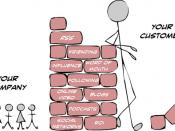J. Griffiths Ltd is an old British traditional bike factory, which was a major manufacturer in UK. They have a wide range of bicycle for different kinds of customers. Today the profits are declining rapidly and there is an increase of the competition from South East Asia. Those factories are more competitive and have a higher line of product, a better quality, a shorter lead time... which is very attractive for the customer.
The company has two sites : Perry Barr, which is the biggest one, but does not have place for extension and there is a waste of space because there is 5 weeks stock of work in progress ; and the other site has the Plastic moulding company which is in Wolverhampton. The factory has the opportunity to sell the site of Wolverhampton, but there is the problem to know how they can organise itself to put all the machines in the main site, what they should change ...
which explain the first question.
For the second question we have to consider a purchasing strategy, which induce the partnership with the suppliers ; we have to choose if we want to try to have few suppliers, a dual sourcing, tiering, a local sourcing, ... and which kind of problem we can anticipate.
The company can buy an Italian bicycles firm, which is a gears supplier, is located in Europe so give to the factory one door for the European market, new suppliers (maybe cheaper), but it gives some problem too, like the language and the understanding, the currencies, the culture, ... It is therefore more difficult to have good relation with the supplier and to transfer to him our knowledge. The relational problem the factory can have with the Italian company can justify the second question.
The factory Perry Barr site knows some problems. It is a lot of all kind of wastes. But the one which are the most important for using just one site and having the machine of the two sites in the same is the waste of time on hand, processing itself and unnecessary stoke on hand. Indeed, there are more than 30% of the acreage which is use for the work in progress materiel and the raw material store takes up 20%... So we have more than 50% of the Perry Barr site which is not use for machines (there is less than 40% for it). That is why we can try to move to a Just In Time (JIT) process, which will try to reduce the wip's stock of 5 weeks to 1 day of stock.
If we do that, we will have some space to put some machines, the Plastic Moulding Company for example, because we will win around 20% of space and we have 10% free, we just need 25% to have enough space. We can believe that we will have some raw material in common, so we will put it in the same location and we will use less space.
That is why we have to understand why we have so many stock of wip. In the case study it is say that we make big quantity of components because the set-up time is big (from 15 to 90 minutes). We should evaluate how many bikes we can do in a day and try to organise ourselves to have at worst two days of wip's stock. We should try to organise in one other way the machines that for.
That kind of organisation will reduce the waste of transport, because it will not be on movement to go to the storage and to come back. So we will decrease the unnecessary motion, because we will re-organise the machines (we do not want a functional organisation, we want that the bikes are done quickly and we do not have to waste our motions).
We have the problem of the lead time, because, for example, if we have the correct item in stock we will need three days to deliver it, we should give it in one day to the customer. But the problem is if we do it immediately, we cannot bring some bikes which are going close to the same place together. So it will give an extra cost which we cannot neglect. We have to measure if we can do it or not, or check with the other annum and statistics how we can aggregate some bikes together to improve the lead time. To move the Plastic Moulding Company in the Perry Barr site can help to create easily the bikes in shorter times, because it will not be any transport between both sites and they will not have to wait for the items, they will have to do it.
The JIT take care of what want the customer to be sure to sell its products. That is why we have to try to talk to our retailers, to know what the people want. In the case study they say that the customers do not like the quality of our product, the lead time, ... We have to ask what they want, what they will buy. That is why, for example, we can do a market survey to understand them. We do not have a lot of retailers and distributors that is why we have to think how we can be closer. I think we can try to meet them often, to understand what they are waiting for, to study what are doing the competitors and to understand why we have that kind of results. If we want to do some JIT, we have to deliver our products more often than once a week, because like that, we can answer to what is waiting really the customer. For example, in France, there is a too big stock, which does not reply to what the customer is waiting for, which is very important for the selling. We have lot of products in stock but it is not what they want, that is why we do not sell it. What the customers expect is a better quality because our competitors can do it and they have shorter lead time and a bigger rank of products than us. That company does not do a new design for its bikes, which can explain why they have a decrease of selling, because the fashion is always changing.
To apply a real JIT, we have to look after the suppliers too, because the JIT look for all our expending, how we can spend less money, but we have to try to have fewer and closer suppliers. To be closer to our suppliers, the simpler is to have fewer suppliers and to visit them often.
The problem is that this company cannot do a JIT process, because it is a small society, so they have small quantities (JIT is done for big societies, with big quantities) and they have less power with the suppliers than other big companies. Besides they have hundred suppliers, which can seems to be a lot for a small factory like that, because they cannot have a big influence on it, they have to do lot of papers, ...
A purchasing strategy is a strategy where we consider that the quality is very important, we try to have fewer suppliers like that we can have a bigger impact on them and then we create more easily belief relation between the customers and the suppliers.
To build a trust relation with the customer is important because we can check easily the quality of the products, but we are not sure to have a big impact on the supplier in this case (because we have a small factory and we order small quantities) so we can try to negotiate but we are not sure to be heard by the supplier or he can increase the price of the items and we will not look somewhere else even if this supplier will not be bargain anymore. That is why we have to look carefully if we can trust or not one supplier and in which terms. As Andrew Cox says, everything is about power in a company and it is very important to know how the power is distributed in a company to know which advantages we can have or not.
To have one supplier give some advantages : we have fewer administrative works to do, fewer papers and we can easily build a trust link between the supplier and the customer. But if we have just one supplier, we will have fewer kind of items delivered in our company, so we will have fewer kind of final products and it is one of the satisfaction problem of the customer. One other important problem of having that kind of strategy is that if our supplier has a break of stock, we will feel it more than if we had five suppliers for the same product. We might feel it and stop our production as long as the supplier can deliver us. So we have to stop the machines and it will increase the lead time, which will not satisfy the customer and will degrade the corporate image.
I think we have to try to a few suppliers strategy, because we cannot have a single sourcing strategy and tiering is not interesting because we are a small company. To have a local sourcing company is not interesting in our case, because we have to consider the economy of scale, if we just use local suppliers, we will mess up some opportunities, even if sometimes we have to pay the transport, it can be cheaper than having local sources.
I think that having a close relationship with the supplier is important and not an adversarial relationship, because we need him and we need to trust him. That is why I think it is better to have a transactional or a partnership relationship. The most important thing here is the power of the suppliers, but we do not forget the power of the customers, who are required for a company.
It can be very interesting to buy the Italian bicycle company, because it can give some advantages to our society. This Italian company is one of our supplier, so if we buy it we can product alone for example all of the gears we need. It is a vertical extension : we control more and more steps of the fabrication of our product. At the end, we can do some economies of scale. It does not change anything about the transport because we had to pay it before, so it does not change it, except that we do not have three suppliers anymore, we do not have to import it from the USA for example.
Moreover that Italian company has some other suppliers which we can hope are less expensive than our and when we will buy that company we will have its contacts and we can maybe find new interesting suppliers. That company can teach us a new way of work, we can combine the knowledge, because we do not have the same culture so we might do not have the same way of working. That is one reason which is interesting to buy it : have new cheaper relations and new working methods.
But it can have some disadvantages or problems. Because when you buy a foreign company, at the beginning you have to decide with which laws you will use to sign the contracts. You have to choose which currency you can use to buy the factory and after between both companies, there is still that currency problem. It is expensive to change all the time of currency.
To deal with an Italian company give the problem of the understanding, because they do not speak the same language and even if one person speak perfectly one other language, sometimes there are some misunderstood, we always have to check if the other has well understand what we wanted to say.
We do not have the same culture with the Italian, so we cannot say everything like when we talk to one fellow-countryman. We do not know if they have the same aim of quality and we have to explain why we want that quality and how we can do it (to transfer our knowledge) without miffing people. It is not always easy to do it, because we have to talk in one other language or to be understood in our language, so we cannot say all the things we want to say.
To buy that company can open one door on the European market, which is important because our company want to develop that market. It can be a door because Italy is one European country and its market seems to be in Europe. We can use its contact to sell our bikes and to understand what the customers want.
I think that it is important to consider that opportunity if we want to have a bigger European market share.
In conclusion, that company J. Griffiths Ltd has a lot of opportunities to change its working method, which is necessary, because they are loosing some market share and they have to understand why and how they can change it. They have to define a new strategy and to try to put it on. We do not have enough information to say what they have to do. But they cannot apply a JIT or purchasing strategy like we can find in books, because it is a small company and every company has specificity. The purchasing strategy is a step of a JIT strategy, the JIT strategy is more complete, because it looks for more things like the stocks, wastes ...
The company can choose between many ways to develop one strategy. If they buy the Italian company and sell the site of Wolverhampton for example they could major the Perry Barr site in the children's bikes and the Italian company in the rest. Like that we can check more easily the quality of the bikes because we will put in each site qualified people, who can understand what is wrong and why.
Appendices
Bibliography :
Auteur: Cox, Andrew W., - Editeur: Routledge - 289 pages - 2001 , Supply Chains, Markets and Power : Mapping Buyer and Supplier Power Regimes
Power and supply chain relationships
Auteur: Emerald Insight Staff, - Editeur: Emerald Group Publishing Limited - 84 pages - 2004
Author(s):Andrew Cox VINE; Volume: 31 Issue: 2; 2001 Research Paper
Logistics : An Introduction to Supply Chain Management
Auteur: Waters, C. D. J., - Editeur: Palgrave Macmillan - 367 pages - 2003
Title: Expert Advice for JIT Implementation
Author(s): K. Fiedler, J.E. Galletly, J. Bicheno
Journal: International Journal of Operations & Production Management
ISSN: 0144-3577
Year: Jun 1993 Volume: 13 Issue: 6
DOI: 10.1108/01443579310038994
Publisher: MCB UP Ltd
http://www.smthacker.co.uk/just_in_time.htm
"TQM...if"
Author(s):Jon Choppin
Managing Service Quality; Volume: 5 Issue: 3; 1995 Technical paper
Supply Chain Operations Reference Model Version 7.0 Supply-Chain Council, 2005.
Lean Manufacturing That Works : Powerful Tools for Dramatically Reducing Waste and Maximizing Profits
Auteur: Carreira, Bill, - Editeur: AMACOM - 303 pages - 2004
Power and supply chain relationships
Auteur: Emerald Insight Staff, - Editeur: Emerald Group Publishing Limited - 84 pages - 2004
http://www.wto.org/
Title: Incorporating shortage strategies in industrial marketing
Author(s): William B. Wagner, Srinath Gopalakrishna
Journal: Journal of Business & Industrial Marketing
ISSN: 0885-8624
Year: Dec 2001 Volume: 16 Issue: 7 Page: 540 - 552
DOI: 10.1108/EUM0000000006191
Publisher: MCB UP Ltd


